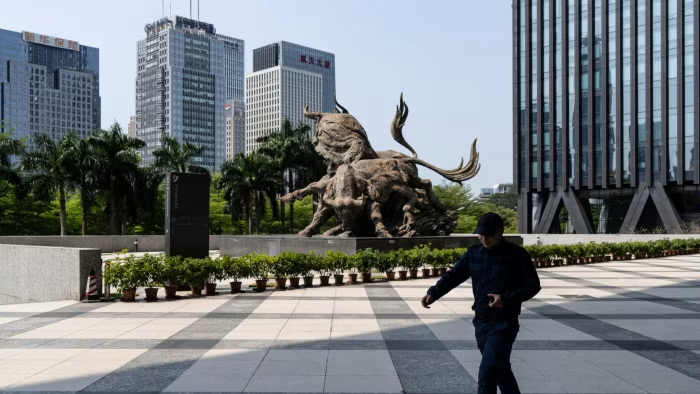Unlock the Editor’s Digest for free
Roula Khalaf, Editor of the FT, selects her favourite stories in this weekly newsletter.
Sometimes a room requires a full overhaul, and sometimes it just needs a judicious tweak. If colour drenching your living…

Unlock the Editor’s Digest for free
Roula Khalaf, Editor of the FT, selects her favourite stories in this weekly newsletter.
Sometimes a room requires a full overhaul, and sometimes it just needs a judicious tweak. If colour drenching your living…

Stay informed with free updates
Simply sign up to the US economy myFT Digest — delivered directly to your inbox.
The writer is an adjunct professor at NYU School of Law and former head of North America for CIC, China’s sovereign wealth fund
In February, President Donald Trump directed the Treasury and commerce secretaries to develop a plan for a US sovereign wealth fund.
Although such a fund has yet to be established, the government’s acquisition in August of a 10 per cent equity stake in US chipmaker Intel demonstrates that active state participation in industrial sectors of strategic importance to national security is part of an increasingly clear and focused strategy.
The commerce secretary Howard Lutnick said at the end of September that the administration’s aim is to “get chip manufacturing significantly onshored”. And on Monday, the government announced it would take a 10 per cent stake in Canadian mining company Trilogy Metals in a bid, as the secretary of the interior Doug Burgum put it, to secure the supply of critical minerals.
The Trump administration’s equity-for-grants deal with Intel did three things, each of which sheds light on America’s evolving industrial strategy.
First, it sent a market signal that the US is committed to Intel’s long-term prospects. The company is the country’s best chance to compete with Taiwan Semiconductor Manufacturing Company and Korea’s Samsung in chip fabrication.
Second, the stake was a “poison pill” to dissuade the company from fully exiting the manufacturing sector. TSMC is the dominant player in chip manufacturing, especially advanced artificial intelligence chips, so Wall Street may advise Intel to focus on chip design instead. But Intel pulling out of manufacturing would be detrimental to the government’s efforts to shore up domestic chip making for reasons of supply-chain stability.
Third, the Intel deal was clearly intended to “crowd in” further public-private partnership. Within days of the US government taking its stake, Japan’s SoftBank announced its own $2bn investment in Intel, followed by Nvidia’s $5bn design and manufacturing partnership with the company.
However, even the $8.9bn of US funding, plus SoftBank’s $2bn, will not fully finance Intel to build up its AI chip manufacturing capacity. It may need to invest $10bn in each of the next five years if it is to succeed at making leading-edge chips.
Intel’s plan to open a new manufacturing facility in Ohio, for example, has been repeatedly delayed, not only because of the company’s financial troubles, but also its lack of AI chip manufacturing orders from the biggest customers.
US government funding alone wouldn’t address all of Intel’s problems, which is why Nvidia’s decision last month to invest $5bn in its struggling rival as part of a deal to develop chips for PCs and data centres is so significant. This partnership not only provides Intel with a critical revenue pipeline but also creates a demonstration effect: if the world’s dominant AI chip designer entrusts Intel with responsibility for manufacturing, it could catalyse further private market capital to invest in a company seen as vital to US technological sovereignty.
Will the US approach succeed? It’s worth comparing these recent ad hoc efforts to boost chip manufacturing in America with China’s National Integrated Circuit Industry Investment Fund, which demonstrates Beijing’s ambition to build a competitive domestic foundry ecosystem. After significant investment by NICIIF in Shanghai-based Semiconductor Manufacturing International Corporation, the company now makes advanced AI chips for Huawei, and is striving to catch up with TSMC as well.
Both the US and China have decided that they can’t afford to outsource their chipmaking future. Technological sovereignty is their common destination, and they are resorting to the same kind of strategy, albeit with their own distinctive characteristics, to get there.

The Pentagon has sought to procure up to $1bn worth of critical minerals as part of a global stockpiling spree to counter Chinese dominance of the metals that are essential to defence manufacturers.
The Trump administration’s accelerated effort to bolster the national stockpile is outlined in public filings published in recent months by the Pentagon’s Defense Logistics Agency. It follows export restrictions imposed on many of the materials by China, which dominates the supply chains for critical minerals and permanent magnets needed for technologies from smartphones to fighter jets.
“They [the US defence department] are incredibly focused on the stockpile,” said one former defence official. “They’re definitely looking for more, and they’re doing it in a deliberate and expansive way, and looking for new sources of different ores needed for defence products.”
Another former defence official said the $1bn is an acceleration over previous stockpiling efforts.
This week Beijing unveiled sweeping new export controls on rare earths and related technologies, prompting Donald Trump to say on Friday that he would no longer meet Chinese leader Xi Jinping later this month as planned.
The US would impose an additional 100 per cent tariff on Chinese imports in response, Trump said, adding: “There is no way that China should be allowed to hold the world ‘captive’ but that seems to have been their plan.”
Beijing’s restrictions have fuelled fears in the US and Europe about their continued access to the metals.
Critical minerals are a national security priority for the Pentagon because they are crucial to virtually every weapons system, as well as technologies such as radar and missile detection systems. The defence department’s recent stockpiling activity is a marked acceleration driven by the Trump administration’s renewed enthusiasm for critical minerals. Some of the metals the Pentagon is seeking to acquire were not previously being stockpiled.
“China’s ability to turn off the supply of these critical minerals would have a direct, palpable and adverse effect on US ability to field the kind of high-tech capabilities that we’re going to need for any kind of strategic competition or conflict,” said Stephanie Barna, a lawyer at Covington & Burling in Washington.
Recent expressions of interest from the DLA include plans to buy up to $500mn of cobalt, up to $245mn of antimony from the domestic US Antimony Corporation, up to $100mn of tantalum from an undisclosed US company and up to a combined $45mn of scandium from Rio Tinto and APL Engineered Materials, a chemical manufacturing company based in Illinois that has offices in Japan and China.
The plans show that the US government was “conscious of how critical this stuff is, and wants to support whatever domestic capacity they have,” said one sector executive. “It’s very early days for western governments to stockpile critical minerals but they’re increasingly focused on it.”
The DLA stockpiles dozens of alloys, metals, rare earths, ores and precious metals, which are stored in depots throughout the country. Its assets were valued at $1.3bn as of 2023. The materials can only be released by the president in times of declared war, or if deemed necessary for national defence by the under-secretary of defence for acquisition and sustainment.
The price of germanium has soared this year as exports from China have fallen, with western traders warning of “panic” in the market as companies struggled to get hold of it. The germanium issue is one the Pentagon is trying to fix.
The price of antimony trioxide has almost doubled over the past 12 months, while carmakers have struggled to secure rare earth materials this year after China restricted certain exports.
Trump’s One Big Beautiful Bill Act contains $7.5bn for critical minerals, including $2bn to bolster the national defence stockpile which the Pentagon intends to spend by late 2026 or early 2027.
The OBBA also includes $5bn for defence department investments in critical minerals supply chains and $500mn for a Pentagon credit programme to spur investments.
One former defence official said several offices involved in securing the critical mineral supply chains were now “flush with cash” following the passage of the OBBA.
The DLA declined to comment.
Analysts at Jefferies said the Rio deal, for around 6 tonnes of scandium oxide, was at a price that was “higher than market expectations”. Global consumption of scandium oxide is around 30-40 tonnes, according to price reporting agency Fastmarkets, with China the leading producer.
The DLA stated in its filings that Chinese export controls on scandium had “constrained the supply chain”.
The deal with USAC for antimony, meanwhile, would grow a stockpile “sufficient for industrial base mobilisation in a national emergency” and enable the company to continue producing in what was a “volatile” sector, it said.
USAC sources the mined material that it turns into metal from Canada, Mexico, Australia, Chad, Bolivia and Peru, chief executive Gary Evans told the FT. The company reported revenues of $15mn in 2024 and does not report its annual antimony metal production. The DLA deal for around 3,000 tonnes of antimony metal compares to total US antimony consumption in 2024 of 24,000 tonnes, according to the US Geological Survey.
“Market participants have been taken aback by the volumes requested by the DLA across several metals. Many consider the quantities to be unrealistic, especially within the proposed five-year timeframe,” said Cristina Belda, from Argus Media. “In most cases, the requested tonnages exceed the US’s annual production and import levels.”
The DLA has also sought information for the potential acquisition of rare earths, tungsten, bismuth and indium to add to the stockpile.
The volumes of bismuth and indium were “significant” given the global size of the markets, said Solomon Cefai from Fastmarkets. “It is hard to imagine a situation where non-China supply would not be pressured by the volumes the DLA is looking at,” he said.
The DLA is seeking information for the potential acquisition of 222 tonnes of indium ingots, which compares to US consumption of refined indium of around 250 tonnes in 2024, according to the USGS.

Stay informed with free updates
Simply sign up to the Financial & markets regulation myFT Digest — delivered directly to your inbox.
US banks are set for an unprecedented easing of capital rules, which new research suggests could unlock $2.6tn in lending capacity and increase pressure on regulators elsewhere to follow suit.
The upcoming dilution of US banking regulation, much of it already signalled by Washington, is likely to free up almost $140bn in capital for Wall Street lenders, according to research by consultancy Alvarez & Marsal.
Since Donald Trump returned to the White House, US authorities have embraced a much more bank-friendly approach, committing to loosen many of the rules that forced banks to increase their loss-absorbing capital buffers after the 2008 financial crisis.
The reduction of capital requirements is set to reinforce the dominant position of big Wall Street groups, boost their capacity to finance huge investments in AI and data centres and allow them to return more capital to shareholders.
“We think the Trump administration is kicking off a major wave of deregulation, unlocking a huge amount of capacity, which will give a massive economic boost and an earnings uplift,” said Fernando de la Mora, co-head of financial services at Alvarez & Marsal.
The New York-based consultancy predicted US banks would benefit from a 14 per cent reduction in their requirements for common equity tier one, a capital buffer that gives them capacity to absorb losses.
It forecast this would result in a 35 per cent boost to their earnings per share and a 6 per cent increase in their return on average tangible common equity — a benchmark used by investors.
The report, due to be published on Monday, provides detailed estimates of the impact of changes to banking regulation across the world. It forecast UK regulators would follow the lead of the US and reduce British banks’ capital requirements by about 8 per cent.
However, it expects EU bank capital requirements to keep rising, predicting a 1 per cent increase, while capital levels for Swiss banks are forecast to rise by up to 33 per cent. The Swiss government has proposed higher capital levels that could require UBS to raise up to $26bn, as authorities seek to strengthen financial stability following the bank’s rescue of crisis-hit rival Credit Suisse.
“This is going to drive a further market share gain by US banks and the UK will just about hold its market share, while the Swiss and the EU banks will lose more ground,” said de la Mora.
JPMorgan Chase, the largest US bank, is set to be one of the main beneficiaries. The easing of restrictions is forecast to release $39bn of its capital, lifting its earnings per share by 31 per cent and its return on equity by 7 per cent.
Michelle Bowman, a longtime critic of stricter bank capital rules, was appointed this year as vice-chair of supervision at the US Federal Reserve and has since committed to ease restrictions that she has blamed for pushing lending into private credit markets.
US regulators have already presented proposals to water down requirements for banks to maintain a preset amount of high-quality capital in proportion to their overall assets.
They have also announced plans to reform the extra capital buffers required of the biggest US banks and to rework the annual stress tests that impose more restrictions on them.
“There is a capital investment boom in the US to be financed — for AI, data centres, energy infrastructure and some reshoring,” said Huw van Steenis, vice-chair of consultancy Oliver Wyman. “This recalibration of regulation will help banks lean into this financing wave.”
However, European regulators worry about the risks of looser bank capital requirements. Christine Lagarde, the European Central Bank president, this month cautioned against “regulatory rollback”, while Bank of England governor Andrew Bailey warned about “the baby being thrown out with the bathwater” when reforming financial regulation.

Stay informed with free updates
Simply sign up to the Artificial intelligence myFT Digest — delivered directly to your inbox.
Elon Musk’s xAI is pushing to build so-called world models, joining rivals such as Meta and Google in the race to develop artificial intelligence systems that can navigate and design physical environments.
The San Francisco-based start-up hired specialists from Nvidia over the summer to work on these next-generation AI models, which train on videos and data from robots to understand the real world.
World models could push the capabilities of AI beyond that of the large language models, trained on text, that underpin popular AI tools such as ChatGPT and xAI’s Grok.
Two people familiar with the plans said the company was building world models with a view to applying them in gaming, where they could be used to generate interactive 3D environments. One of the people added that they could be applied to AI systems for robots.
xAI has hired Zeeshan Patel and Ethan He, two AI researchers from Nvidia with experience in world models. Nvidia has been a leader in developing this technology with its Omniverse platform, which creates and runs simulations.
Some tech groups have vast expectations of world models, which could unlock uses for AI beyond software and computers in physical products such as humanoid robots. Last month, Nvidia told the Financial Times that the potential market for world models could be almost the size of the present global economy.
xAI would release a “great AI-generated game before the end of next year”, Musk said in a post on X, confirming a target the billionaire set last year.
On Tuesday, xAI launched its latest image and video generation model, which it said had “massive upgrades” and is free to use.
Current video generation models, such as OpenAI’s Sora, generate frames of images for videos by predicting patterns learned from training data.
World models would be a big advance as they would have a causal understanding of physics and how objects interact in different environments in real time.
The company is advertising for technical staff in both image and video generation to join its “omni team”, which “creates magical AI experiences beyond text, enabling understanding and generation of content across various modalities, including image, video and audio”.
Salaries for these jobs range from $180,000 to $440,000. It also has an open position for a “video games tutor”, who will train Grok to produce video games and enable “users to explore AI-assisted game design”, for $45 to $100 an hour.
Musk follows other leading AI labs, such as Google and Meta, that are also working on these systems.
However, world models remain a huge technical challenge. Finding sufficient data to simulate the real world and to train such models has proved difficult and costly.
Michael Douse, head of publishing at Larian Studios, which develops the video game Baldur’s Gate 3, said on X this week that AI could not solve the “big problem” for the games industry, which is “leadership [and] vision”.
He added that the industry did not need “more mathematically produced, psychologically trained gameplay loops [but] rather more expressions of worlds that folks are engaged with, or want to engage with”.
xAI, Patel and He did not respond to requests for comment.
Additional reporting by Hannah Murphy in San Francisco

Unlock the Editor’s Digest for free
Roula Khalaf, Editor of the FT, selects her favourite stories in this weekly newsletter.
Rising demand for commercial aircraft will create space for rivals to challenge the Airbus-Boeing duopoly, according to the chief executive of Brazilian planemaker Embraer.
Francisco Gomes Neto said he saw the potential for new competitors to produce narrow-body jets, which at present are only built by the European and US companies.
“When I look at the projections for the next 20 years, we see an opportunity for 40,000 aircraft in that segment,” he told the Financial Times at the company’s headquarters in São José dos Campos. “That’s a lot. I think there is room for more than two manufacturers, right? I mean, maybe three or four.”
Embraer is the world’s third-biggest planemaker and dominates the smaller regional jets that carry fewer than 150 passengers, although its output is far behind industry giants Airbus and Boeing.
The $10.6bn group has been studying options for the next generation of its commercial and business jets but Gomes Neto said a decision was not due until the next decade at the earliest because it was focused on selling existing products. Embraer’s latest and largest model, the E195-E2, can carry up to 146 passengers.
Recent crises at Boeing and late deliveries of aircraft from both the US manufacturer and Airbus amid persistent supply chain problems have fuelled talk of whether Embraer might be tempted to enter the single-aisle market.
Gomes Neto said some of Embraer’s customers “say that they would like to have more options”. However, he cautioned that there was a “big gap” between saying something and buying something.
Ron Epstein, a Bank of America analyst, believes there is a case for Embraer to develop a larger aircraft.
“The big question for them is strategically what do they do next?” he said. “Look out over the next 20 years at demand for commercial aircraft and I think almost for sure there’ll be room for a third player,” he added, noting that Boeing’s crises had reminded airlines that “having another player in the market is good for everybody”.
Embraer, Epstein said, was one of the few companies that could “bring a new product to market relatively cost-effectively”.

Gomes Neto’s comments echo those of executives at Boeing and Airbus, who have said no decisions on whether to launch a new single-aisle jet are imminent. Both are focused on delivering on orders for their existing narrow-body models — Airbus’s best-selling A320 family of jets this week overtook Boeing’s 737 as the most popular commercial aircraft in history by deliveries, according to industry data.
Industry executives believe China’s Comac is the most likely to disrupt the dominance of Boeing and Airbus. The state-owned company launched its first domestically made airliner, the C919, in 2023 and its customers include the country’s three biggest carriers as well as a few overseas airlines.
Going head-to-head with Airbus and Boeing would be a risky endeavour for Embraer. A past attempt by Bombardier to break into narrow bodies almost proved ruinous, leading the Canadian manufacturer to withdraw from commercial aircraft production and focus on business jets.
Gomes Neto said Embraer would not want to put the company’s “financial health” at risk. Embraer plans to almost double revenues from its existing regional and business jets, with a target of reaching $10bn by the end of this decade.
The company is enjoying strong demand for its regional jets despite being subject to the Trump administration’s baseline 10 per cent import tax in its biggest market. It successfully lobbied Washington for an exemption from the additional 40 per cent tariff imposed on Brazil two months ago, with Gomes Neto meeting the US treasury, commerce and transportation secretaries to press its case.
Even so, Gomes Neto said the 10 per cent duty would add about $80mn in costs to the group, chiefly resulting from the import of parts for its private jets that are assembled in Florida. He expressed optimism that the remaining tariff would be removed from Brazilian aerospace goods. Adjusted half-year earnings before interest and tax were $253.8mn.
Embraer has not been immune from the industry’s supply chain challenges. Gomes Neto said deliveries of components such as engines and fuselage parts were still delayed but that the situation was improving, and the company was still on track to reach 100 commercial aircraft deliveries per year by 2028.
He added that the group was pursuing several international sales opportunities for its regional jets, including in India.


The company is also seeking to boost overseas sales of its military products, including the KC-390 Millennium tanker-transport aircraft, and hopes to benefit from higher military spending from Nato countries. Eight European countries have so far ordered the KC-390.
Embraer is working on plans to assemble the KC-390 in the US as part of a bid to win a contract with the US Air Force for the Next Generation Air Refuelling System programme.
Separately, Gomes Neto said he expected the company’s electric air taxi, Eve, to enter commercial service by the end of 2027. The subsidiary, which is seen as a key potential growth area for Embraer, is among several companies developing battery-powered aircraft that can land and take off vertically to take passengers on short-range trips.

Chinese stocks are outpacing global peers by the widest margin in eight years, in a sign that policymakers’ efforts to revive the market are bearing fruit even as many foreign investors hesitate to return.
The MSCI China index has surged 35 per cent this year, compared with a 14 per cent gain in the MSCI World index of developed market stocks, the largest margin of outperformance since 2017.
This year’s rally comes after many global fund managers last year branded China — whose stock market had been in near-constant decline since peaking in early 2021 — “uninvestable”, following a government crackdown on the private sector and a long-running real estate crisis.
However, Beijing has been pushing to improve corporate governance at state-owned enterprises and private companies, and has launched huge monetary and fiscal stimulus, including measures for financing share buybacks.
Investors say these measures — together with a drive to increase the insurance sector’s equity purchases and concerted buying by the so-called national team of state institutions — are starting to turn the stock market into a viable alternative to property.
“Part of the reason money went into real estate was the stock market was viewed a little bit like Macau,” said Brendan Ahern, chief investment officer at KraneShares, an exchange traded fund provider with products investing in China. He was referring to the tendency for locals to view the market as a casino rather than a place to allocate long-term savings.
“If you can make the stock market an appealing source of returns, it would arguably divert money from going back into real estate. That makes sense for the government,” he added.
Mark Headley, chair of Matthews Asia, an investment manager, said the government viewed the reforms as necessary to help its capital markets compete with the US.
“The Chinese government and the Chinese people have finally recognised that just owning a fifth apartment somewhere is not the perfect savings plan,” he said.
China’s stock market is small relative to its economy. The country accounted for 16.8 per cent of global GDP in 2024 but just 10.3 per cent of global stock market capitalisation, according to the World Bank. China accounts for only 3.35 per cent of MSCI’s all-country world index.
However, the number and quality of Chinese stocks have improved significantly over time, said Archie Hart, a portfolio manager at Ninety One in London. Of the more than 5,000 companies listed in mainland China, 2,504 have a market capitalisation of more than $1bn, according to data provider Wind.
“I look at it on a very long-term perspective. Thirty years ago your choices were state-owned,” Hart said. “Today you’ve got a fantastic choice of ecommerce companies, tech, manufacturing companies, consumer brands.”
Regulators have stepped up their efforts to improve stock market returns and corporate governance at China’s state-owned companies. Measures include tying managers’ key performance indicators to share price performance and return on equity.
When a stock market rout at the start of last year worsened, Beijing brought in Wu Qing, nicknamed the “broker butcher”, as head of the country’s securities regulator in a move to ease volatility and stabilise the market.
In a speech this year, he referred to foreign investors as “important participants in China’s capital market” and said he would accelerate measures to open up capital markets to the outside world.
In September last year, the China Securities Regulatory Commission encouraged listed companies “to lawfully and compliantly use M&A, equity incentives, cash dividends, investor relations management, information disclosure and share repurchases to elevate their investment value”.
“There’s a big effort by the regulators in these agencies to make the mainland Chinese companies credible companies for international investors,” said Amar Gill, secretary-general of the Asia Corporate Governance Association.
But some in the industry see resistance within parts of government to market reforms that could diminish the state’s influence over corporate decision making.
“The tension, I would say, is between the agencies, the regulators and the party,” Gill said. “The party is still wanting to have control of state-owned enterprises and to some extent private companies as well, while the regulators are looking to see how they can make these companies focus on shareholder value.”

China’s outperformance this year comes as global investors seek to diversify their portfolios, which are often highly concentrated in the US.
However, US-China tensions and macroeconomic uncertainty are deterring many from reconsidering mainland stocks, even as Hong Kong proves attractive and other Asian markets such as South Korea and Japan are widely seen as less risky.
“To attract both domestic and foreign investors is going to take two to three years of steady returns,” said Headley.
Foreign flows to China’s mainland market have been muted this year, according to EPFR data tracking ETFs and mutual funds domiciled outside China. Mainland stocks received just $1.2bn of net foreign investment this year.
Some foreign investors remain unconvinced that China’s reforms have gone far enough, with many seeing recent initiatives as signs that Beijing wants to increase its control over companies and markets.
“There is still a huge sceptical slant” in western countries towards China, said the ACGA’s Gill.
Ryan Manuel, managing director of Bilby, which analyses government policy using artificial intelligence, said there was still tension between reforming China’s capital markets and the government’s fixation on controlling strategically vital sectors.
“Industrial policy muscles are stronger than capital markets reform muscles,” said Manuel.
Nevertheless, for Chinese investors, the options are limited. “Where else are you going to put money in China with the real estate market being dead?” Manuel added.
Additional reporting by Haohsiang Ko in Hong Kong

It’s the moon’s last night in Waning Gibbous before we’re at a half moon. There’s less and less visible each night, but keep reading to see what you can see tonight, Oct. 12.

In late October 1975, a heavily shielded spacecraft, the Soviet Union’s Venera 9, parachuted into the atmosphere of Venus.
Then, having landed, it did something extraordinary: it beamed back the first images ever captured from the surface of…

For many nature enthusiasts, few scenes are as distressing as finding a stranded whale or dolphin lying helpless on the beach. When these animals are still alive, marine biologists and volunteers rush to assist, shielding them from the sun and…